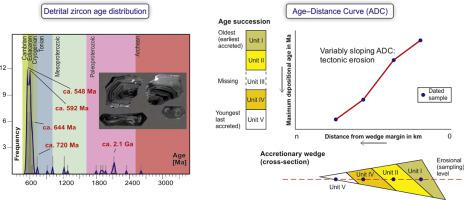当前位置:
X-MOL 学术
›
Earth Sci. Rev.
›
论文详情
Our official English website, www.x-mol.net, welcomes your
feedback! (Note: you will need to create a separate account there.)
Detrital zircon geochronology and processes in accretionary wedges
Earth-Science Reviews ( IF 10.8 ) Pub Date : 2020-08-01 , DOI: 10.1016/j.earscirev.2020.103214 Jiří Žák , Martin Svojtka , Jaroslava Hajná , Lukáš Ackerman
Earth-Science Reviews ( IF 10.8 ) Pub Date : 2020-08-01 , DOI: 10.1016/j.earscirev.2020.103214 Jiří Žák , Martin Svojtka , Jaroslava Hajná , Lukáš Ackerman

|
Abstract The detrital zircon U–Pb geochronology has been widely employed to analyze accretionary wedges over the past decade. The goal of this paper is, first, to briefly review this rapidly growing field of research and then to explore the exciting potential of the detrital zircon geochronology for interpreting processes in accretionary wedges. A few general conclusions may be derived especially from examples along the Circum-Pacific Belt as well as from the Blovice accretionary complex, Bohemian Massif, examined here in detail. (1) The detrital zircon age spectra are typically a mixture of cratonic and arc-derived material. While the former helps to resolve the provenance of various terranes, the latter may detect changing magmatic arc tempos. (2) The maximum depositional ages, inferred from the youngest zircon ages, are close to the true ones as the trench-fill sediments are sourced from active arcs through rapid erosion and transport to the wedge toe. (3) The maximum depositional ages of the oldest unit within an accretionary wedge provide a key information on the onset of accretion, which, however, may be delayed from the subduction initiation. The onset of strongly accretionary behavior may be linked to changes in the subduction parameters and arc activity. Furthermore, we introduce a new concept of the maximum depositional Age–Distance Curves (ADCs). These curves are plots of the maximum depositional ages on the abscissa with respect to a distance along a sampling transect (running across-strike of different tectonostratigraphic units composing the accretionary wedge) on the ordinate and may reveal a wealth of information on a variety of dynamic processes within accretionary wedges. Four main types of the ADCs are defined on the basis of their overall shape and course: (1) Linear ADCs may track continuous accretion whereas (2) variably sloping ADCs may reflect tectonic erosion, increase in the rate of deposition and accretion, or tectonic duplication. (3) Stepped ADCs may record the latter two processes, but also out-of-sequence thrusting while (4) sawtooth ADCs may result from emplacement of older units within younger (olistoliths) or, vice versa, from tectonic underplating and exhumation. It should be noted, however, that the ADCs are nonunique in some cases, i.e., the same curves may reflect different processes. Finally, we point out several issues that still remain poorly understood and would deserve attention in future research. For instance, detailed sampling along transects is desirable to quantify temporal variations in the rates of sediment-supply to the trench and in the rates of accretion. It is also not clear whether the maxima and minima in the zircon age spectra truly match the changing arc tempos, or whether they are affected by other factors such as erosion or sediment transport. One of the exciting fields is detrital zircon U–Pb and fission-track multichronology, which may elucidate the complete sediment trajectories. And, last but not least, the detrital zircon (multi-)chronology should be integrated with detailed sedimentological and structural studies to address the key issue: how the accretionary wedges respond to the temporally evolving subduction zone dynamics.
中文翻译:

增生楔中的碎屑锆石年代学和过程
摘要 在过去的十年中,碎屑锆石 U-Pb 年代学已被广泛用于分析增生楔。本文的目标首先是简要回顾这个快速发展的研究领域,然后探索碎屑锆石年代学在解释增生楔过程中的令人兴奋的潜力。一些一般性结论可以特别从环太平洋带沿线的例子以及 Blovice 增生复合体波西米亚地块中得出,这里详细检查。(1) 碎屑锆石年龄谱通常是克拉通和弧衍生材料的混合物。虽然前者有助于解决各种地体的来源,但后者可能会检测到不断变化的岩浆弧节奏。(2) 最大沉积年龄,从最年轻的锆石年龄推断,由于沟渠填充沉积物来自活跃的弧形,通过快速侵蚀和运输到楔形趾部,因此接近真实情况。(3) 增生楔内最古老单元的最大沉积年龄提供了有关增生开始的关键信息,然而,这可能会延迟于俯冲开始。强烈增生行为的开始可能与俯冲参数和弧活动的变化有关。此外,我们引入了最大沉积年龄-距离曲线 (ADC) 的新概念。这些曲线是横坐标上最大沉积年龄相对于纵坐标上采样横断面(构成增生楔的不同构造地层单元的跨走向)的距离的图,可以揭示各种动态变化的丰富信息。增生楔内的过程。ADC 的四种主要类型是根据它们的整体形状和过程定义的:(1) 线性 ADC 可以跟踪连续的吸积,而 (2) 可变倾斜的 ADC 可以反映构造侵蚀、沉积和吸积速率的增加或构造复制。(3) 阶梯式 ADC 可能会记录后两个过程,但也可能是无序推进,而 (4) 锯齿形 ADC 可能是由于较旧的单元在较年轻的(橄榄石)内就位,反之亦然,来自构造底板和折返。然而,应该注意的是,ADC 在某些情况下是非唯一的,即相同的曲线可能反映不同的过程。最后,我们指出了几个仍然知之甚少的问题,在未来的研究中值得关注。例如,需要沿横断面进行详细采样,以量化向海沟提供沉积物的速率和堆积速率的时间变化。还不清楚锆石年龄谱中的最大值和最小值是否真正与变化的弧节奏相匹配,或者它们是否受到侵蚀或沉积物迁移等其他因素的影响。令人兴奋的领域之一是碎屑锆石 U-Pb 和裂变径迹多年代学,它们可以阐明完整的沉积物轨迹。最后但并非最不重要,
更新日期:2020-08-01
中文翻译:

增生楔中的碎屑锆石年代学和过程
摘要 在过去的十年中,碎屑锆石 U-Pb 年代学已被广泛用于分析增生楔。本文的目标首先是简要回顾这个快速发展的研究领域,然后探索碎屑锆石年代学在解释增生楔过程中的令人兴奋的潜力。一些一般性结论可以特别从环太平洋带沿线的例子以及 Blovice 增生复合体波西米亚地块中得出,这里详细检查。(1) 碎屑锆石年龄谱通常是克拉通和弧衍生材料的混合物。虽然前者有助于解决各种地体的来源,但后者可能会检测到不断变化的岩浆弧节奏。(2) 最大沉积年龄,从最年轻的锆石年龄推断,由于沟渠填充沉积物来自活跃的弧形,通过快速侵蚀和运输到楔形趾部,因此接近真实情况。(3) 增生楔内最古老单元的最大沉积年龄提供了有关增生开始的关键信息,然而,这可能会延迟于俯冲开始。强烈增生行为的开始可能与俯冲参数和弧活动的变化有关。此外,我们引入了最大沉积年龄-距离曲线 (ADC) 的新概念。这些曲线是横坐标上最大沉积年龄相对于纵坐标上采样横断面(构成增生楔的不同构造地层单元的跨走向)的距离的图,可以揭示各种动态变化的丰富信息。增生楔内的过程。ADC 的四种主要类型是根据它们的整体形状和过程定义的:(1) 线性 ADC 可以跟踪连续的吸积,而 (2) 可变倾斜的 ADC 可以反映构造侵蚀、沉积和吸积速率的增加或构造复制。(3) 阶梯式 ADC 可能会记录后两个过程,但也可能是无序推进,而 (4) 锯齿形 ADC 可能是由于较旧的单元在较年轻的(橄榄石)内就位,反之亦然,来自构造底板和折返。然而,应该注意的是,ADC 在某些情况下是非唯一的,即相同的曲线可能反映不同的过程。最后,我们指出了几个仍然知之甚少的问题,在未来的研究中值得关注。例如,需要沿横断面进行详细采样,以量化向海沟提供沉积物的速率和堆积速率的时间变化。还不清楚锆石年龄谱中的最大值和最小值是否真正与变化的弧节奏相匹配,或者它们是否受到侵蚀或沉积物迁移等其他因素的影响。令人兴奋的领域之一是碎屑锆石 U-Pb 和裂变径迹多年代学,它们可以阐明完整的沉积物轨迹。最后但并非最不重要,











































 京公网安备 11010802027423号
京公网安备 11010802027423号